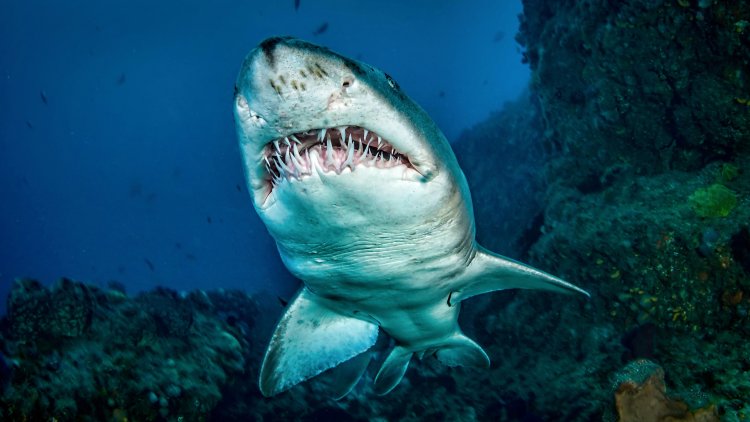Shark Teeth Aren’t Just ‘Triangular Pointy Things’
Scientists are studying ancient teeth for clues about the ocean's past.

This article was originally published by Hakai Magazine.
When a real-estate development threatened the remains of a 13th-century coastal fishing site on southern Brazil’s Santa Catarina Island in 1996, archaeologists rushed to excavate. They rapidly collected what they could from the Rio do Meio site—pottery, tools, animal remains. The historical site now sits under a popular beachfront property. Fortunately, though, the artifacts are tucked safely away in the museum at the Federal University of Santa Catarina (UFSC).
About 750 to 500 years ago, Indigenous peoples journeyed to the area to fish. Sharks were an important part of their diet, and, after a successful hunt, the fishers would butcher bull sharks, great white sharks, sand tiger sharks, and other species at Rio do Meio before transporting the meat away. Luckily for Guilherme Burg Mayer, a graduate student in ecology at UFSC, the hunters left the sharks’ severed heads behind. The university museum’s collection from Rio do Meio includes teeth from at least eight different species—and shark teeth are a treasure chest of information.
In a recent paper, Burg Mayer and his colleague compared these excavated teeth with modern shark teeth collected in the same region from 1975 to 2010. Using a method called stable-isotope analysis, which yields insights into an animal’s diet and environment, the team identified differences between the two sets of teeth that likely reflect how the region’s marine ecosystem has changed over the centuries, and how sharks have adapted.
“I think a lot of folks just think that shark teeth are triangular pointy things,” says Sora Kim, a stable-isotope biogeochemist at UC Merced who also studies shark teeth but wasn’t involved in the Rio do Meio analysis. This approach is relatively new, Kim says, and scientists can learn a lot from the shape and chemistry of shark teeth.
Like human teeth, shark chompers contain collagen, a type of protein that includes different elements, such as nitrogen and carbon that animals get from their food. Although scientists can’t tell exactly what an animal has eaten from analyzing its teeth, Burg Mayer’s team was able to glean clues about the sharks’ diets and their rankings as predators by comparing different forms of nitrogen, called isotopes, between the two dental sets. Higher nitrogen-isotope values suggest that an animal is feeding higher on the food chain—that is, more likely to be eating carnivorous or herbivorous prey than they are to be eating plants.
[Read: A look into the wondrous life of sharks]
The researchers found that, centuries ago, different types of sharks were feeding on animals that occupied the same level of the food web—prey that lived near one another and ate similar things. Ecologists see this type of diet overlap as a good thing, Burg Mayer says, because it points to a more resilient food web where predators have lots of different prey to munch on. If one type of tasty fish disappears, for example, sharks have plenty of others to eat.
In contrast, the diets of Brazil’s modern sharks have little overlap. Instead, sharks appear to be either chowing down on prey that gets little attention from other sharks or eating a more diverse combination of prey from different levels of the food web. A possible explanation for this shift, Burg Mayer says, is that sharks have become less picky as fish species have declined in number, forcing them to snack on new foods. To the researchers, this change signals a less resilient ecosystem.
When the researchers zeroed in on one species—the sand tiger shark—they found that it has moved up the food chain over time to become one of the ecosystem’s top predators. Burg Mayer says that modern members of the species are picking their prey from higher on the food chain because it’s become easier; there are fewer sand tiger sharks left to compete for the biggest and best meal options. Sand tiger sharks have been overfished in Brazil for decades and, in 2018, were declared critically endangered in the region. (Fishing for the species was banned a few years before, though the meat is still sold illegally.)
But, as Kim points out, stable-isotope analysis can show only that changes have occurred; it can’t explain why. Overfishing may or may not be to blame for sharks’ changing diets. And because sharks regularly lose and regrow their teeth, a single tooth is more like a snapshot covering a few weeks or months of the animal’s life, not its whole life story, she adds. Ultimately, Kim says, without additional research, it’s difficult to say exactly why sharks are eating different things now than they were several centuries ago.
Regardless, the findings reflect a disturbance in the ecosystem that’s worth further investigation, Burg Mayer says. The study also showcases the resilience of sand tiger sharks even under challenging conditions.
“This particular group is adaptive to the changes,” Burg Mayer says. “It’s trying to survive.”
What's Your Reaction?




















